There were national forecasts of rain for the first week of May, but here on the borders what precipitation arrived didn’t amount to very much. Instead for a while we had some black clouds which only threatened showers. Before too long the sun, very hot overhead by now, was back with us. The new spring was certainly glorious with the full flush of green coming onto the trees and hedges and a mist of bluebells through the woods; I had a wonderful drive early one Sunday morning to shoot at Llanishen, crossing the lower Wye at Bigsweir Bridge and climbing behind Llandogo into the thick green forest which fills both sides of the river gorge above Tintern.
However, superb as spring can be in this part of the world, this was not the kind of weather anglers want to see. The upper rivers were now extremely low, with some rarely seen parts of the river bed exposed under a merciless bright light. Trout could be caught, but they were extremely spooky and the angling was hard work. Often tiny dry flies on very long, fine leaders were the only way to achieve a take. Little CDC flies of size 24 and even 7X and 8X points were being used at times. Taking salmon seemed mostly confined to the bottom of the Wye. These were either fresh fish off the tide below Monmouth or members of the run which arrived in the beats above Monmouth a month before…if they could be persuaded now.
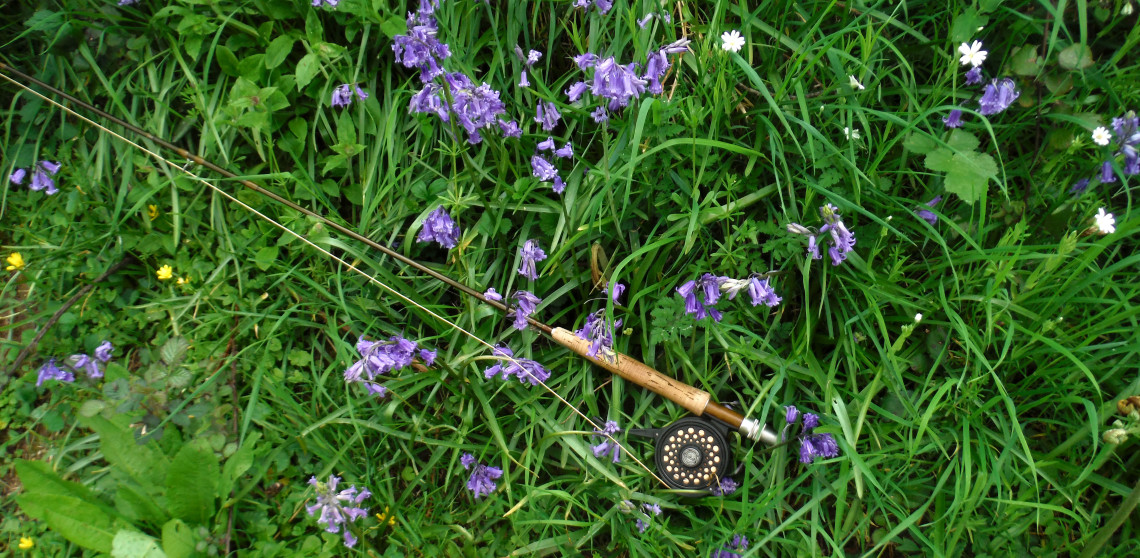 Bluebells by the Monnow
Bluebells by the Monnow Let’s start with some late reports from April. MN from Bristol had a fat 17 inch fish in a bag of 4 trout taken with the dry fly at Doldowlod on the 27th. That’s pretty sure to be a 2 pounder. AS from Stoke on Trent was less than happy with his day at Ashford House on the 28th: “canal-like…no bank work for many years…I wouldn’t book this again as a trout angler.” Even making allowances for the drought affecting the Usk at the moment, that seems a bit harsh. A new footbridge has just been put in. I grant that fishing Ashford House involves a bit of a walk and a bit of a scramble, but on the plus side it has some of the finest trout in the whole river. PD from Cheltenham came to fish the Wye at Abernant on the evening of the 29th seeing “plenty of activity and caught 4 browns on a dry.” Two reports came from the Raby Estate on the River Tees: GW from London caught 8 trout while GA from Leven with a friend had 17. MH from Swansea was fishing Gromaine along with Dolmeudwy pool on the beat below and reported 8 trout to nymphs and spiders.
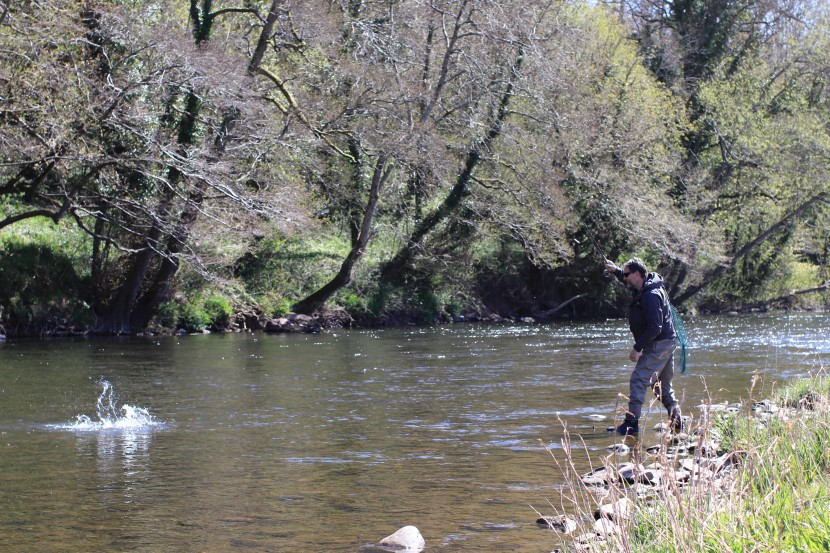 Upper section of Ashford House in April
Upper section of Ashford House in April 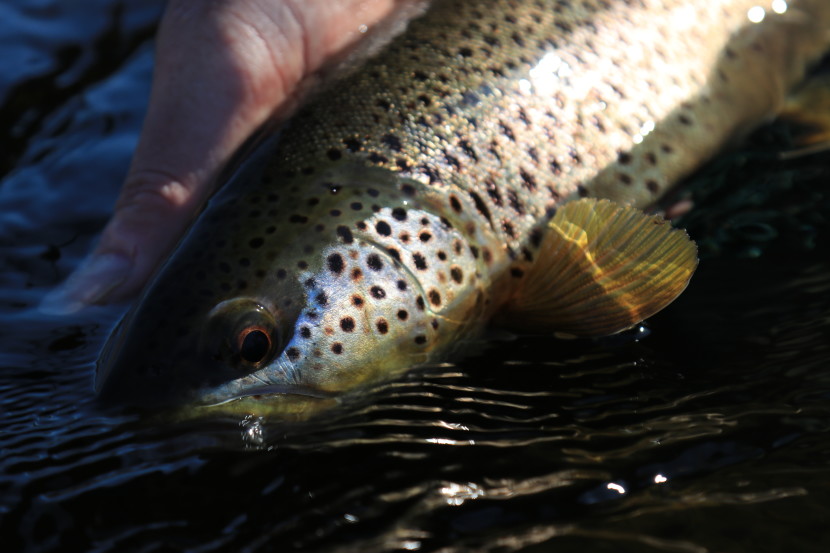 Ashford House brown
Ashford House brown John Harris had an 8 pounds salmon from Chainbridge on the 30th, this being, I think, only the second Usk salmon we have been told about of the year. Ricky Reno had a 9 pounds fish spinning the Wye at Wyastone Leys, while Wyesham reported another fish of 10 pounds. The same fishery on May 1st had a fish of 15 pounds, on the 2nd fish of 20 and 22 pounds, and on the 3rd 9 and 11 pounds. Gillie Mick Sutton caught a 10 pounds salmon on the fly from Goodrich Court, and next evening rescued a net which I had left there while fishing with a client earlier in the day – for which, many thanks. Then another Usk fish: on the 6th Richard Hillman of Merthyr AA had a fine cock fish of 35.5 inches at Abergavenny. I’m not sure whether this was on the Town Water or Ysbytty; the photograph looks like it was taken at dusk or in darkness. Saul Roberts had a fish of 9 pounds from Boys Rocks on the Wyastone Leys beat of the Wye, while on the 8th Chris Winsor fishing on Bigsweir opposite the Florence Hotel had a fish of 11 pounds. Both these were on the fly.
The 4th was a busy day for trout fishers. MF, I’m not sure from where, had a good day up at Llyn Bugeilyn with 24 trout taken on traditional up-country wet flies like Bibio, Zulu and Siver Invicta. He had the right weather for it too, with cloud, a little rain and wind. GG from Colwyn Bay had a difficult day on the Teme at Bucknell: “Quite a waste of time and money. Fishing Passport let me down and especially the admin charge. Bucknell is full of bullocks, so another warning not to bother.” Well, I’m not too fond of frisky bullocks either and would rather the usual sheep were on the riverside pastures, but I think GG’s remarks are a little harsh. The WUF description of Bucknell is quite fair and accurate, in that it does suffer from low flows in such dry weather as we have now. It is also capable of producing some very big trout from those deep holes when conditions are right and flows are high or have been recently. Anglers really should read such descriptions with care and take a reasoned decision before booking. I’m not going to defend the booking charge again, except that it is certainly not a hidden charge and the service has to be paid for somehow.
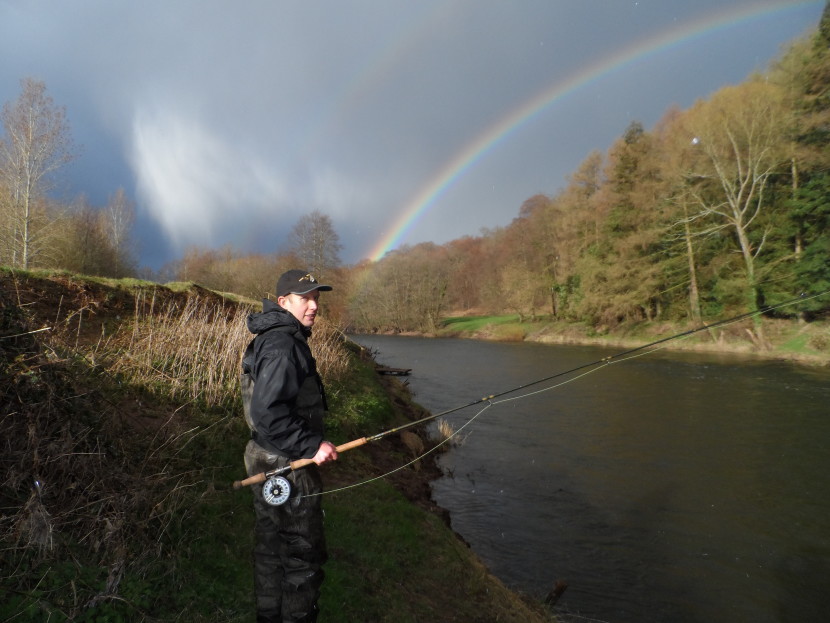 Spring salmon fishing at Chainbridge on Usk
Spring salmon fishing at Chainbridge on Usk 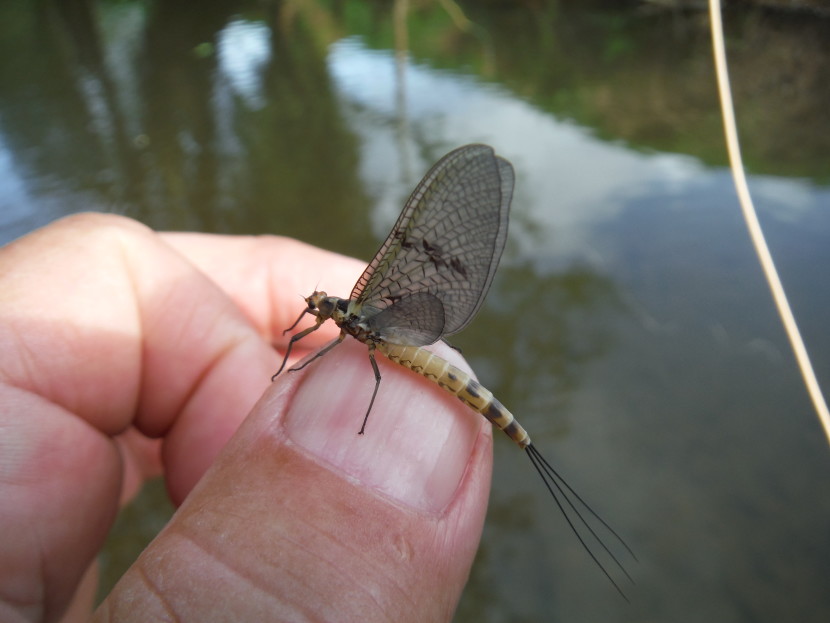 First true mayfly seen, Upper Monnow 6th May
First true mayfly seen, Upper Monnow 6th May RB from Redditch reported 6 trout from the Monnow at Skenfrith. AT from Weobley had 5 from Talybont Reservoir, but felt he had been let down by the weather forecast: “…like most things on the BBC, it’s made up.” Really AT? So cynical! On the 5th AC from Mountain Ash had 5 trout on dry olive patterns from the Usk’s Cefn Rhosan Fawr, which is not an easy beat when the water is low. JW from Stamford had 6 trout from Ty Newydd on the Wye: “Lovely day with plenty of fish coming up for a dry fly.” On the following day AP from Wirral found the true mayfly coming off the Monnow in large numbers at Lower Longtown and managed 3 trout on imitations. DD of Caernarfon managed 8 small trout from Ogwen AA’s lake at Ffynnon Lloer. MR from Winchester took 10 trout on nymphs from Ty Newydd, while IC from Gloucestershire recorded a 17 inch trout from the Usk at Greenbank.
LB of Bath had a trout fishing day on the Abergavenny Town Water and, pretty much inevitably, found his work cut out between swimming dogs, children throwing stones etc. The town meadow at Abergavenny is a busy place when the sun shines. He did find out that a very small sedge pattern flicked under the shading trees and dragged a little usually provoked a response. It’s a strange thing this, but while dry fly fishers for trout spend most of their ingenuity in scrupulously avoiding drag, as the season goes on and more sedges (which do scuttle across the surface) hatch out, there are times when a little drag can be just what the doctor ordered. Grayling often go for it.
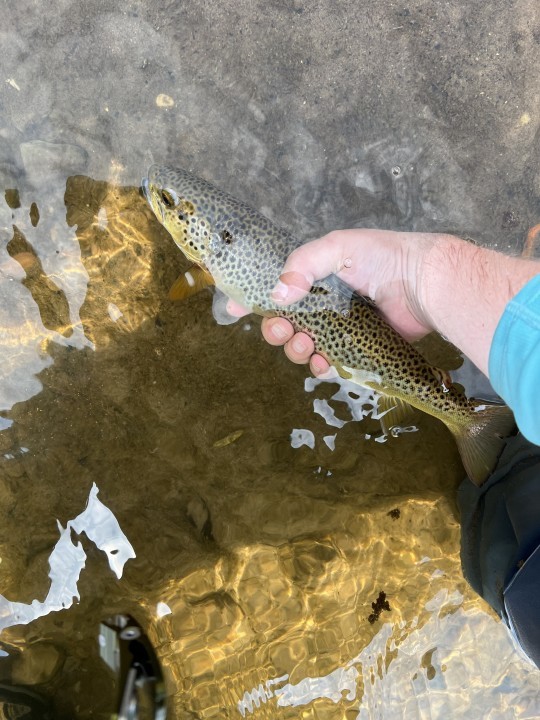 Abergavenny trout - LB from Bath
Abergavenny trout - LB from Bath 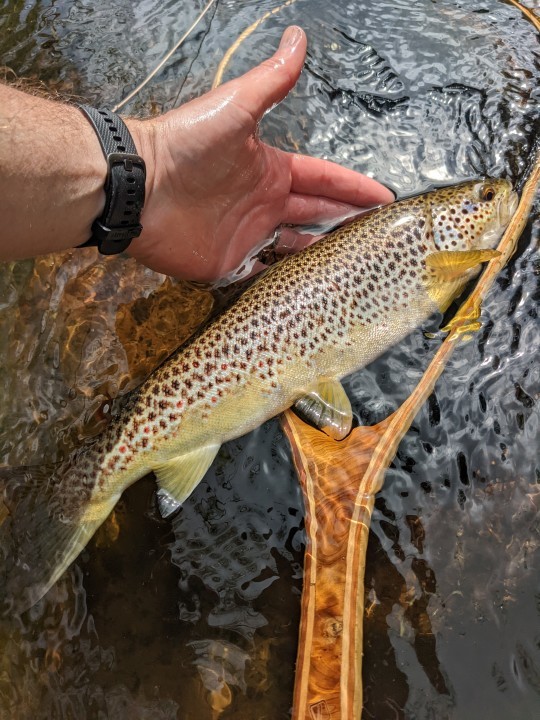 Penpont trout - RL from South Molton
Penpont trout - RL from South Molton 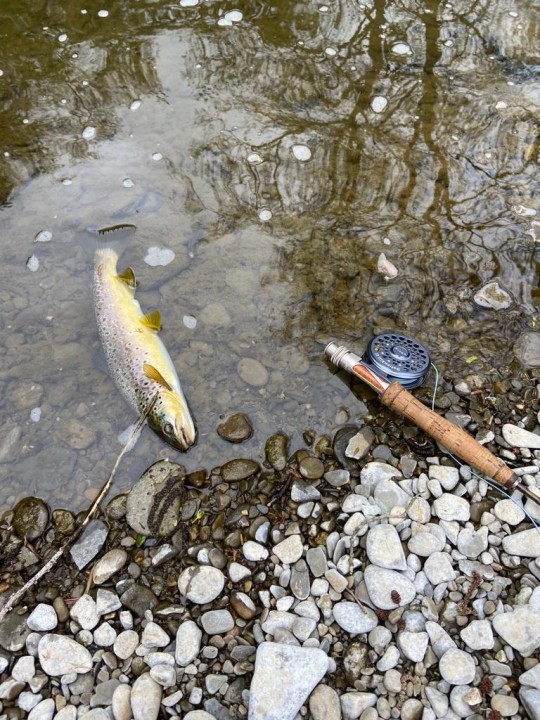 Edw trout - JD from Patrixbourne
Edw trout - JD from Patrixbourne Salmon fishing was obviously a pretty slow business by now. Wyesham reported a fish of 11 pounds on the 9th. Rather surprisingly, given the distinct lack of flow, LB from Bath again was watching small salmon moving up the Goodrich Court beat on the same day, including one fish powering its way up the V shallows. Wyesham scored again with a 9 pounder taken on a Flamethrower.
We did have our rain at last on the 11th, which barely moved the Usk, but the Wye and Irfon had a little lift and some colour. JE from New Malden managed 13 trout from the Edw at Hergest on the 12th using a Parachute Adams. On the following day NM from Corbridge had 8 trout to 2 pounds, mostly on dries, from the Usk’s Upper Tower beat. JL from Street with 3 friends had 22 trout from the Gromaine and Upper Llanstphan beat, mostly on Deer Hair Emergers and Comparaduns. On the 14th the same team had 24 trout to a very impressive 3 pounds from the Usk’s Cefn Rhosan Fawr, mostly on a size 12 Deer Hair Emerger, that excellent fly of Bob Wyatt, who seems to make all his patterns from deer hair and hare’s ear fur. Up on the Raby Estate water of the River Tees, GA from Leven with a friend scored an impressive 50 trout between them. The biggest was a fish of 1.75 pounds, which was broken off, but shortly after took again so that the original Jingler could be recovered from its jaw along with the second fly, the one which landed it. That’s not an unknown event, but pretty unusual all the same.
RL from South Molton with a friend had 13 trout to 16 inches on dries, mostly the Adams, from the Usk at Penpont. SD from Kidlington had a good day on the Edw at Hergest, taking 14 trout, while PD from Cheltenham had much praise for the cooking at the Seven Stars in Aberedw at the bottom of the valley. Not so happy was NE from Bridgwater, who found his access blocked with new barbed wire while trying to fish the River Cammarch near Beulah. I have to admit that it is a while since I was up there, this being a beat less fished, as you might describe it. Perhaps the WUF might have a word with the owner?
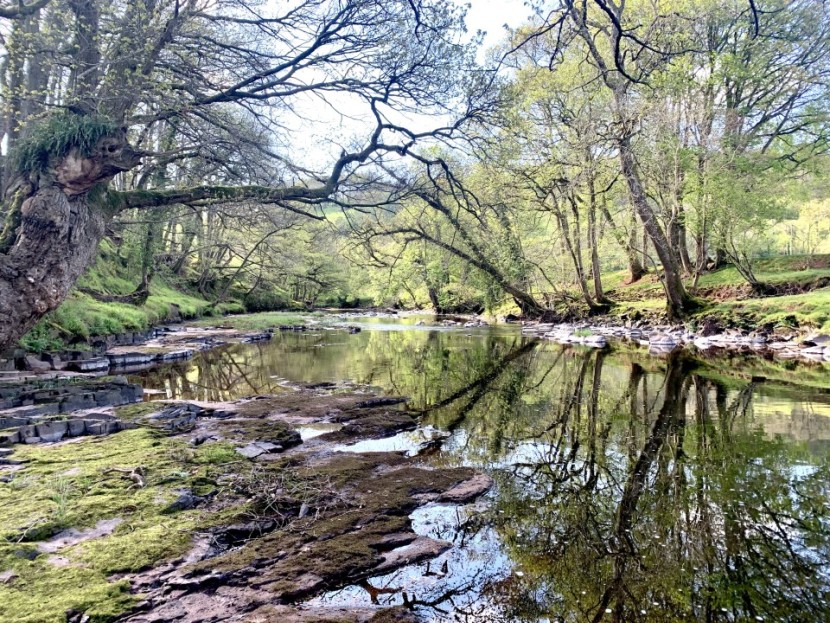 Cefn Rhosan Fawr - AC from Bristol
Cefn Rhosan Fawr - AC from Bristol 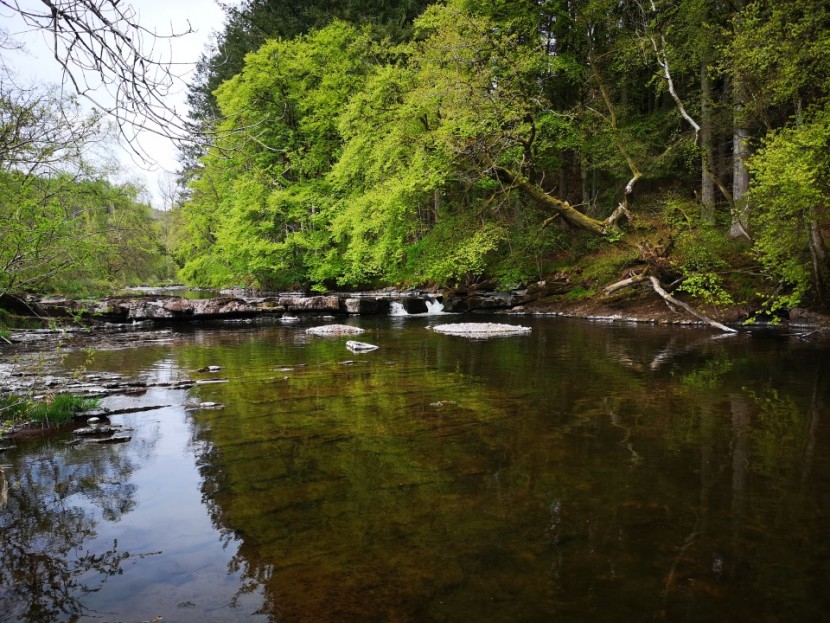 Cefn Rhosan Fawr - AC from Mountain Ash
Cefn Rhosan Fawr - AC from Mountain Ash PK from Barry was very unhappy having driven at one in the morning past the Llwyn On Reservoir (it’s on the A470 passing over the hills between Brecon and Merthyr) and seen lights by the shore and people fishing. To clarify this, the fishing rules for this water are daytime only and there was also another complaint about overnight camping by anglers or poachers. PK, I can well understand your annoyance, but your report doesn’t tell us what you did at the time? If you did in fact call the police at the time I apologise, but if not, I will argue there is little point in watching a crime (theft of fish and fishing rights) being committed and not reporting it till the following day. Nobody would expect you to get out of your car to intervene or take any kind of risk, but an emergency call to the police and also NRW on 0300 065 3000 would have been the right thing to do.
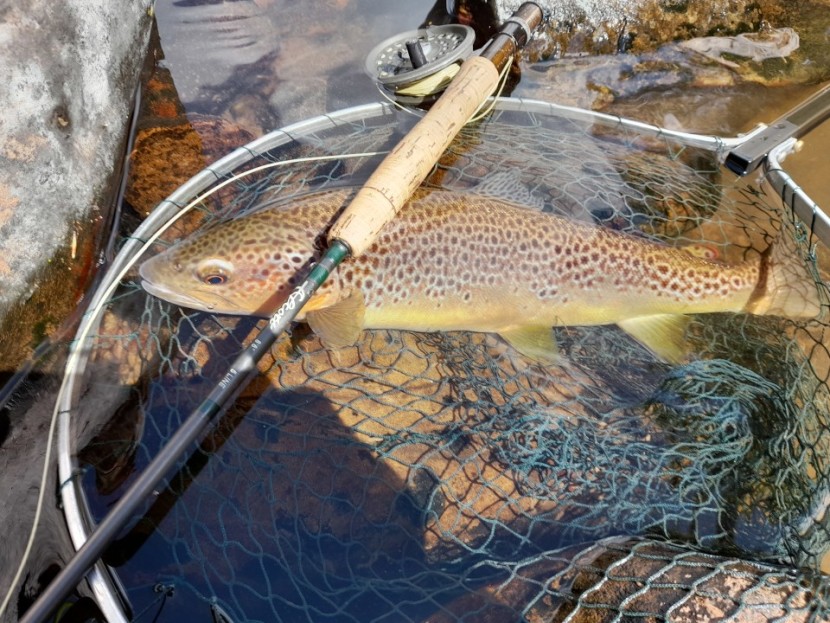 Cwmwysg Ganol - AK from Churt
Cwmwysg Ganol - AK from Churt 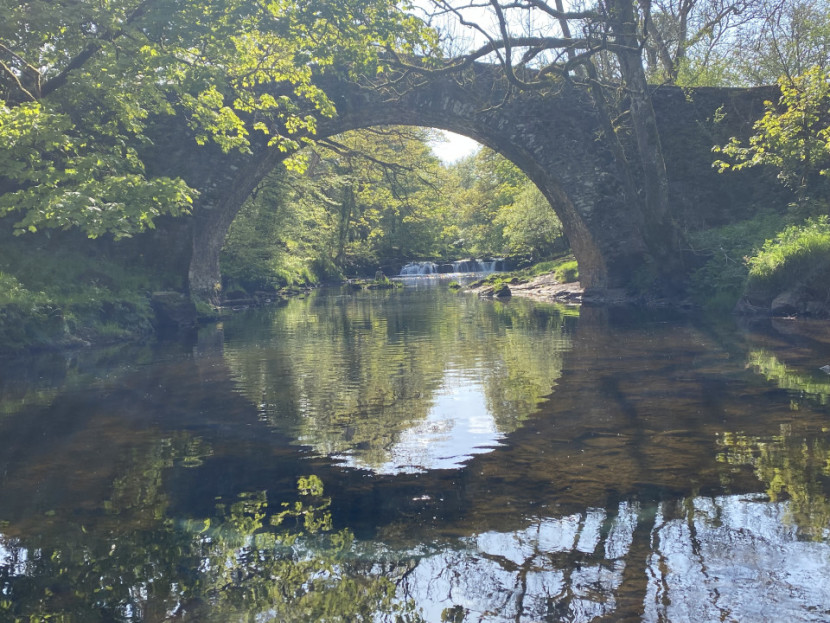 Pantyscallog -AR from Kedington
Pantyscallog -AR from Kedington Salmon fishing was still mostly confined to the bottom of the Wye. Geoff Handley fishing Bigsweir on the 16th took a 10 pounder and then a magnificent springer of 40 inches. An 11 pounder came from Wyastone Leys on the same day, followed by two of 11 and 12 pounds taken at Wyesham with a Mepps spoon on the 17th. Wyesham had two more on the fly the following day and one more on the Mepps on the 19th. I’m reminded that I used to enjoy spinning the Mepps for perch as a boy, but, more to the point, spinning aficionados recommend it for salmon as less likely to be taken deep than the Flying C. Wyesham reported 6 more fish from 8-15 pounds on the 20th, all but one on the Mepps, 2 more 12 pounders with the Mepps on the 20th, and also a 15 pounder on fly. Despite the very low levels, clearly we were still experiencing a steady press of fish into the lower river from the salt. Very occasionally a potted fish trapped in one of the pools upstream showed, but in the circumstance there was not much of a chance for anglers. Later we heard about a 9 pounds fresh fish taken on the 21st on some kind of shrimp pattern by David Harvey up at Spreadeagle (near Glasbury). That one certainly bucked the trend. At this time we also heard that 3 more fish from 9 to 12 pounds had been taken on the lower Usk by Spencer John.
NG from Dilwyn accounted for 15 trout using a dry fly at Cwmwysg Ganol on the 19th while a couple of days later AK from Churt on the same beat caught 10 trout including fish of 2 and 2.5 pounds with a Pheasant Tail Nymph. KG from Bath with a friend had 20 trout at Llyn Bugeilyn. TR from Derby had a long walk while fishing at Llangoed and Lower Llanstephan, complaining that he “…couldn’t work out how to get to the water works parking, not even with Google Earth.” May I very respectfully suggest that it’s not a bad idea to quit messing around with electronic devices and programmes for a moment and just read and follow the directions given? I know this will sound old-fashioned, but you might even print them off if you still have a steam printing machine.
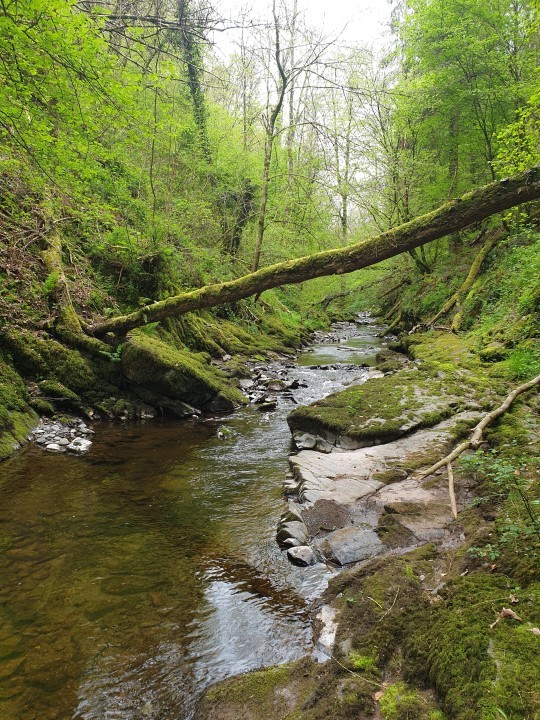 Gorge of the Clettwr - JL from Helston
Gorge of the Clettwr - JL from Helston  Spring on the Monnow
Spring on the Monnow DJ from Halesowen with a friend fished the Usk at Glanusk Ty Mawr / Canals and Rivers Trust. They caught 4 trout including fish of 1.5, 2 and 2.5 pounds and encountered a team dressed in protective clothing surveying a bat community under the aqueduct arch. SC from Leeds with a friend took 12 trout from the Raby Estate water using spiders and Balloon Caddis. I must say it’s interesting to hear news from the North about this fishing on the Tees with such famous falls as High Force and Low Force, all of it described in the late Geoffrey Bucknell’s writing. Originally a “Weldishman” as you might call a man of Kent, he loved the river so much that he moved north for his retirement.
CM from Bridgenorth took a 2.5 pounds trout while salmon fishing on the Wye, while BP from Pembridge was not too unhappy with the Arrow at Monkland: “…once in there are good trout to be had.” The mayfly were hatching and he caught 4 fish. LS from Stoke on Trent took 8 trout from the Seiont Glanrafon water. PK from Stretton Grandison found himself struggling to fish the Arrow at Whittern Lyonshall and asked regular JA from Leominster for tips. For your information PK, Joe Alexander is a guide and so you should be able to engage him for a day – make contact via the Passport instruction page. GP from Stockbridge had a good day at Dinas with 9 trout to 16 inches using Klinkhammer and PTN, while PK from Billingshurst had a dozen trout at Gromaine and Upper Llanstephan by nymphing the fast water. Meanwhile David Burren wrote to me about a day when the mayfly were expected to be up on the Upper Avon at Heale House. Apparently trout were sipping away all morning, but nearly every artificial pattern was refused. It turned out they were taking the empty mayfly shucks from the day before; later in the afternoon they began to rise to a new hatch of duns and good sport followed.
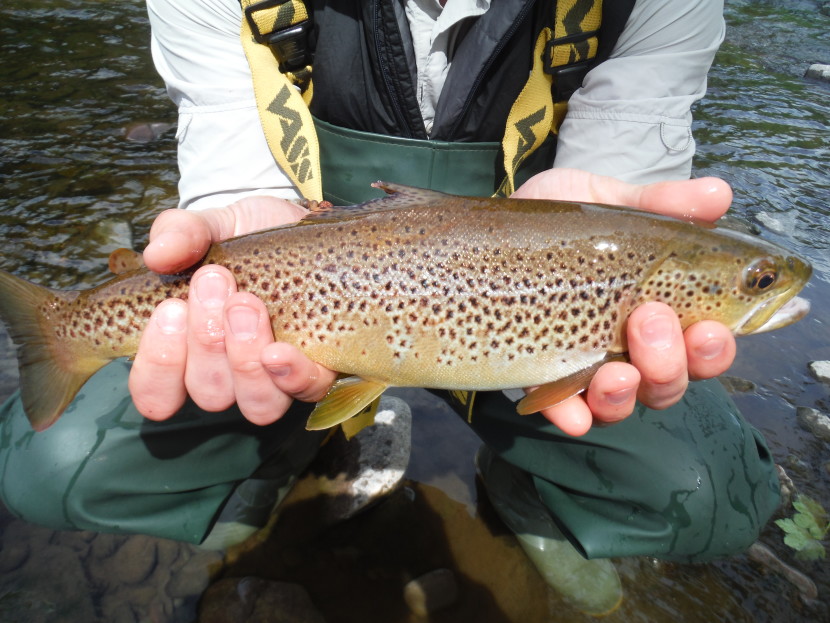 Abercynrig trout - MS of Hereford
Abercynrig trout - MS of Hereford 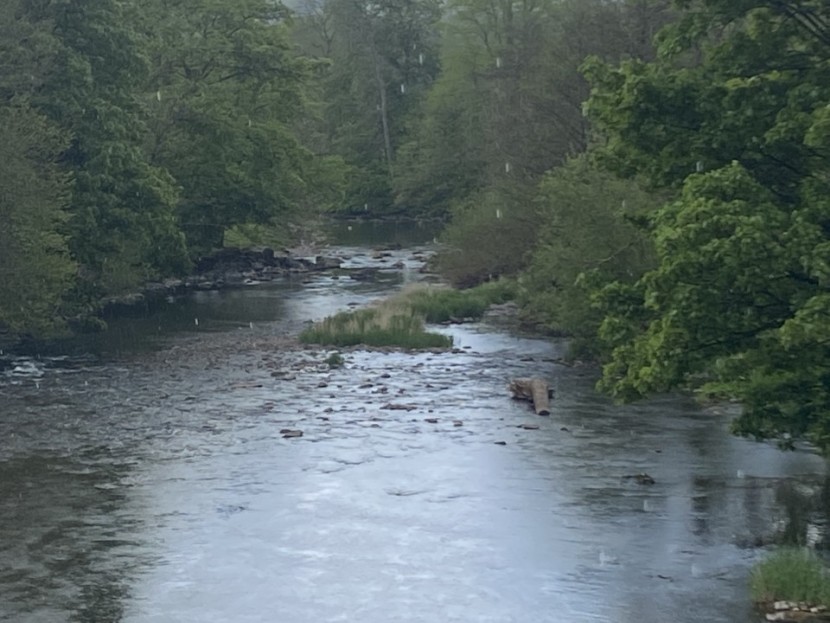 Penpont - PH from Beaumaris
Penpont - PH from Beaumaris On the 24th PT from Kidderminster had a successful day fishing the Ithon at Llandewi, where he found the river bed much changed by winter floods. He caught 16 trout, the best at 14 inches – which, while a nice fish, I’m afraid would not have been anywhere near 2 pounds unless immensely fat. We can only publish what you tell us, but the general advice when reporting is to measure if you don’t have scales, but not to estimate. And of course the welfare of the fish is always paramount so don’t do either if it is going to compromise successful catch and release. AS from Shrewsbury reported a 2.5 pounds trout taken from the Usk at Aberbaiden on something called an SBJ Fly. Help me out here somebody: what is an SBJ Fly if it isn’t something too blasphemous to repeat?
MK from Swansea with a friend was very unhappy with a three rainbow day on Usk reservoir and queried whether the reservoir is being stocked (no fish rising). We often seem to get such remarks criticising fishery management after a day of hard or unsuccessful fishing as if the purchase of a ticket guaranteed the delivery of a certain number of fish, ideally the limit bag. Experienced reservoir fishermen will tell you that the sport just isn’t like that, and we all struggle to catch at times when conditions are difficult. Rather similarly LC from Pewsey with a friend blanked at both Dinas and Ashford House and remarked that the river is very low and “not suitable for fishing.” Well, that is an opinion and the river is certainly very low, but I note that next day GP from Stockbridge managed 5 from Abercynrig. There is usually something which can be done when conditions are tough, so have a try.
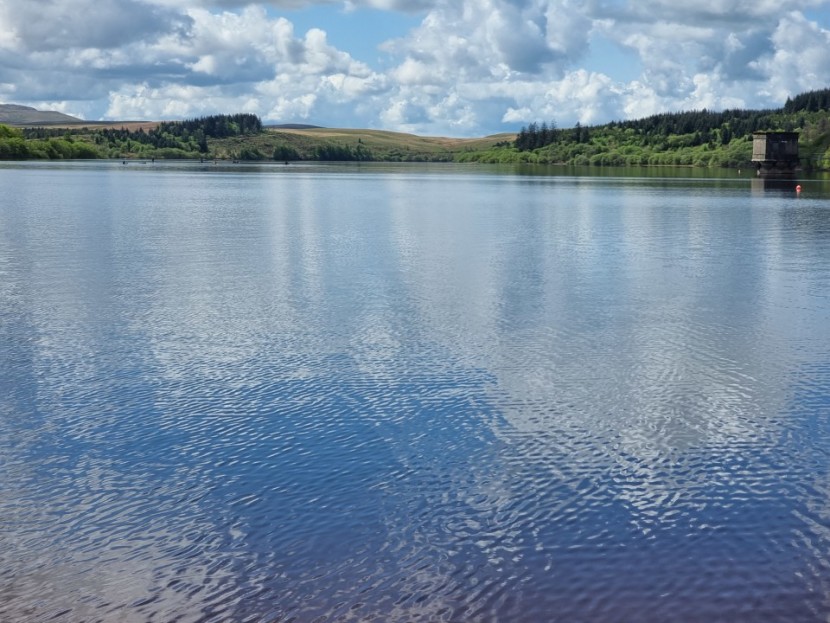 Usk Reservoir - IT from Treorchy
Usk Reservoir - IT from Treorchy 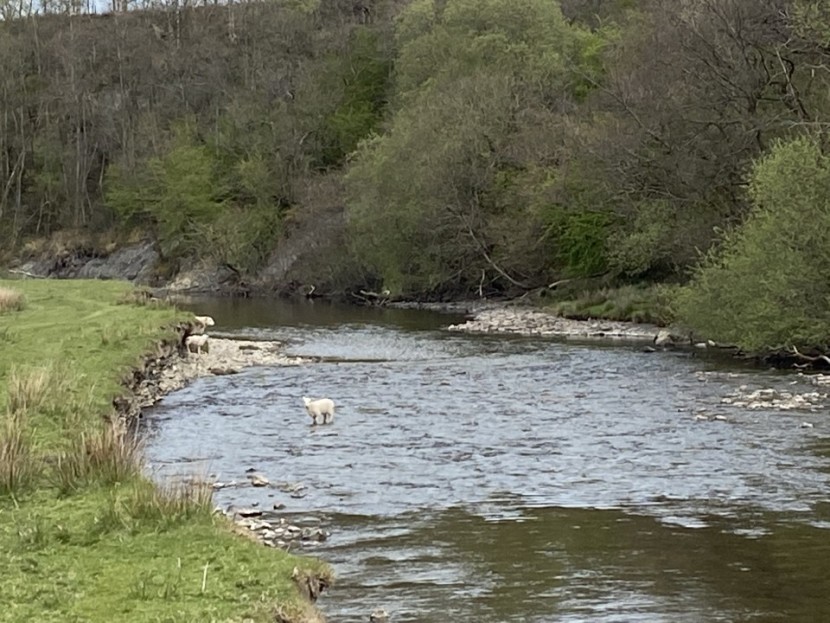 Colonel's Water - PD from Cheltenham
Colonel's Water - PD from Cheltenham On the other hand GP from Stockbridge had just the one trout from Lyepole on the 25th and described the Lugg as “green and milky,” which on the face of it sounds slightly worrying. Interestingly the Lugg, supplied by its deep springs in Radnor Forest, is one of the few streams in this area which have held up in the drought conditions, lately showing around 11 or 12 inches on the Byton gauge. A slight tinge of greyish green colour in the Lugg is normal enough and caused by the sediments in its valley; in fact I think it helps the fishing for this stream not to be running too clear. However, I hope we aren’t now going to have problems of algal bloom in this river as well as in the main Wye, which is already beginning to show signs of colouring up again. You will have seen from the recent newsletter that the WUF is part of a consortium which has submitted a major proposal for DEFRA funding which will combat agricultural pollution; I look forward to reading the details of that if the proposal succeeds.
On the 24th a salmon of 8 pounds was taken on a Flying C by Rodney Welsh from Wyastone Leys. Regular Ricky Reno had a fish of 14 pounds on fly from the same beat next day, while Wyesham also recorded two fly-caught fish: 12 pounds and 14 pounds. Coedithiel at the very bottom of the Wye reported in to the Foundation with 9 salmon so far this season, mostly taken during May. This does not include the probable pink salmon taken in March, which is suspected to be evidence of Russian experimenting between Pacific and Atlantic fishery species. BH from Oxford with two friends were fishing some of the upland lakes and they recorded a very respectable 21 trout from Llyn Egnant. On the 27th PT from Kidderminster caught half a dozen trout from the Glanusk Ty Mawr / Canal and Rivers Trust beat by concentrating on the fast water. JM from Brecon also had half a dozen trout from the Usk Reservoir using a blue and silver Mepps spoon. AW from Llandrindod Wells had 7 trout to 14 inches using a size 18 Greenwells on the Ithon at Llandewi. JA from Leominster had 9 trout from the Lugg at Litton, while AT of Kington used a Grey Wulff to take 6 trout at Hergest Court while mayfly were hatching. These were windy days with scudding black clouds, but the rain didn’t arrive in quantity to our catchments.
Writing on 1st June, yet another day of showers which don’t seem to be landing where we want them, it seems appropriate to try to sum up this spring to date. For too much of it we have been dealing with very low water and the consequences were inevitable. Some surprisingly good trout were caught, mainly from the Usk, but most anglers found they had to work very hard for their fish and there were many difficult days. Wye salmon recorded to date stand at 117, I think, although that must be seen as a minimum figure as reports take time to catch up with us. Very few of those were taken in May and very few above Monmouth. It’s all very worrying. And yet, every tide brings in a few handsome fresh fish into the lower beats. One wonders how we might have fared given a couple of spring floods. One wonders how we might fare in June if we get a couple of floods now.
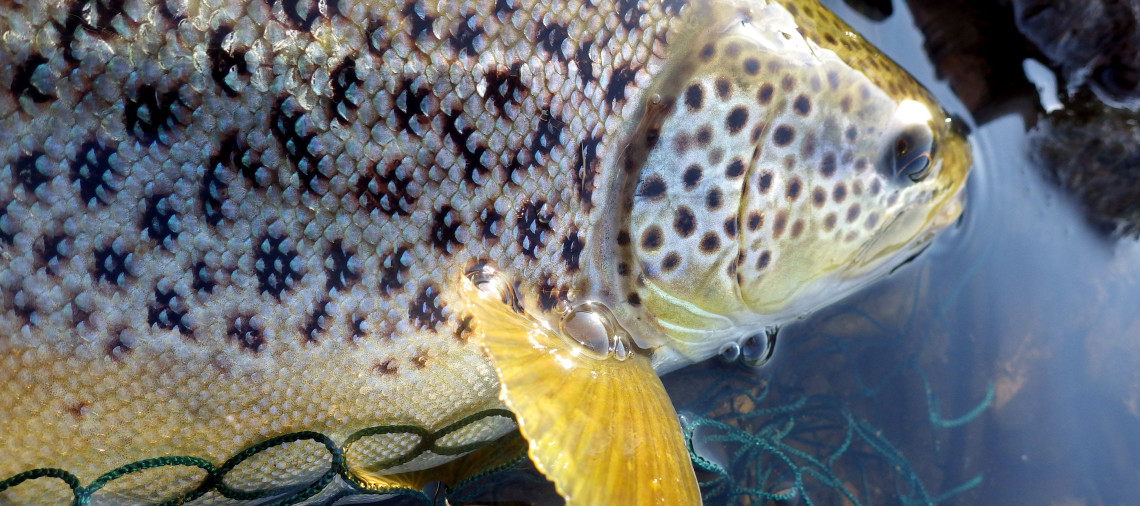
Some say we have become a risk-averse nation, or some of us have. Others tend to groan automatically when the subject of health and safety is mentioned. Certainly a lot of freedoms once accorded to young people, at least when I was a child, have been curtailed. It seems hard to believe now, but on non-schooldays I remember as quite a small fellow being chucked out into the cold air and told not to show up again until tea time. These were still the days of the Just William stories, which must have been grounded in reality. It was great: according to season we dammed up streams, climbed trees, scrumped apples, threw snowballs at each other and any passing cars and generally got up to all sorts of mischief. We also bought and set off fire-works, which were then available at sweet shops along with cigarettes. It was sort of accepted by the adults of that time that it was sort of natural for kids to climb trees and sort of natural also that they would occasionally fall out of them. I seemed to remember the odd broken bone and deep cut amongst members of our gang, but my sister and I survived somehow.
The mood then was based on the idea that outdoor activity was healthy and children and young people, indeed everybody, should get as much of it as possible. The same attitude in a sense is resurgent today, perhaps as a reaction to an indoor life based on screens and the internet which seem to engage more recent generations, or indeed all of us to some extent. Fishing trips and associated safety are usually fairly straight forward, but as you might expect guides today will have a security plan should somebody injure themselves and should certainly have a first aid kit and know where the nearest A&E department is. I do insist on eye protection. The main concern is usually wading safety and at what water height it will be necessary to cancel or delay activities. However, the risks attached to outdoor sports are always there and occasionally they can be serious, particularly when very bad judgement or reckless behaviour is involved. Several examples last year caught my attention.
The first involved what the military would call “negligent discharge” of a fire arm, and a local man was given a two year prison sentence for an accident which had resulted in the loss of an eye for a friend he had shot in the face. The shot gun had been confiscated by the police from one licence holder, then 3 months later transferred to another, who took it to a friend with the idea of selling it to him. Amazingly, apparently in horse play he then pointed the gun at his friend and pulled the trigger…and the gun fired. Defence counsel referred to the fact that the police had been holding the gun, the presence of an “unsuspected cartridge in the magazine” and a belief that the safety catch was engaged. Anybody who shoots will consider these ideas to have little or no connection with safety, a subject which almost everybody in the sport takes extremely seriously. The important points here are that it is the responsibility of everybody who picks up a gun to check that it is empty, not to rely on whoever handled it previously to have done so, and also that all a safety catch does is to block the trigger from being pulled. Even when the safety catch is engaged, the gun can still detonate if knocked or dropped. All this and what follows will be well known to regular shooters, but might be of interest to newcomers to the sport.
 Over and under is now closed - potentially dangerous
Over and under is now closed - potentially dangerous  Semi- auto - potentially dangerous, the action is forward and there might be a cartridge in the chamber
Semi- auto - potentially dangerous, the action is forward and there might be a cartridge in the chamber The great thing about a traditional twin barrelled English shotgun, whether the barrels are arranged side by side or over and under, is that everybody can see whether it is safe or not. If the gun is broken (hinged open between the barrels and the action), it cannot fire and incidentally bystanders can usually confirm that the chambers are empty. If the gun is closed it might be capable of firing and should accordingly be treated as dangerous. (Whether it is engaged or not, the “safety catch” is very often too small to see). This easy monitoring is why conventional shotguns are generally welcome on British game shoots. Even as children our father dinned in to us some basic rules of shot-gun safety for rough game shooting, including the age-old rules about getting over stiles and above all where you point the darned thing:
Never, ever, let your gun
Pointed be at any-one.
The fact that it unloaded be,
Matters not at all to me!
However, the particular shotgun involved in this sad case was an Italian Benelli semi-automatic. Benelli was once famous for racing motor cycles, but in more recent years has made itself a reputation for manufacturing high quality fire arms and is now part of the Beretta group. Semi-automatics have a single barrel, and after the first cartridge is fired use either recoil or gas pressure to bring back the bolt, re-cock the action, eject the empty case and load a new cartridge ready for firing. Most Benellis work on the recoil principle. Semi-automatics are widely used in the USA and on the continent, but less so in this country, where we have conservative tastes about sporting guns. However, game keepers and wild fowlers often use them for convenience, as do some, including me, for the various clay sports. By law in the UK, semi-automatic guns are limited to two cartridges at a time in the magazine and one in the chamber. A blocking rod in the magazine should ensure this, although it can be removed. When shooting sporting clays, no more than two cartridges can be loaded altogether. An important point is that semi-automatics cannot be “broken” and therefore it is more difficult for by-standers to ascertain the safety condition. Nobody can see what is in the magazine. For this reason, on clay sporting grounds except when inside the firing gate and pointing down-range ready to shoot, semi-automatics should always have a very visible “dummy flag round” inside the chamber. While waiting at the stand, traditional guns are always carried broken, empty and muzzle down to the ground; semi-automatics are carried muzzle pointing at the sky, magazine and chamber empty, and with the flag round inserted and in plain view. When shooters are moving between stands, all types of guns are carried zipped away in their slips.
 The bolt is back and the flag round is clearly in the chamber. The gun cannot fire
The bolt is back and the flag round is clearly in the chamber. The gun cannot fire  The gun is broken and cannot possibly fire
The gun is broken and cannot possibly fire 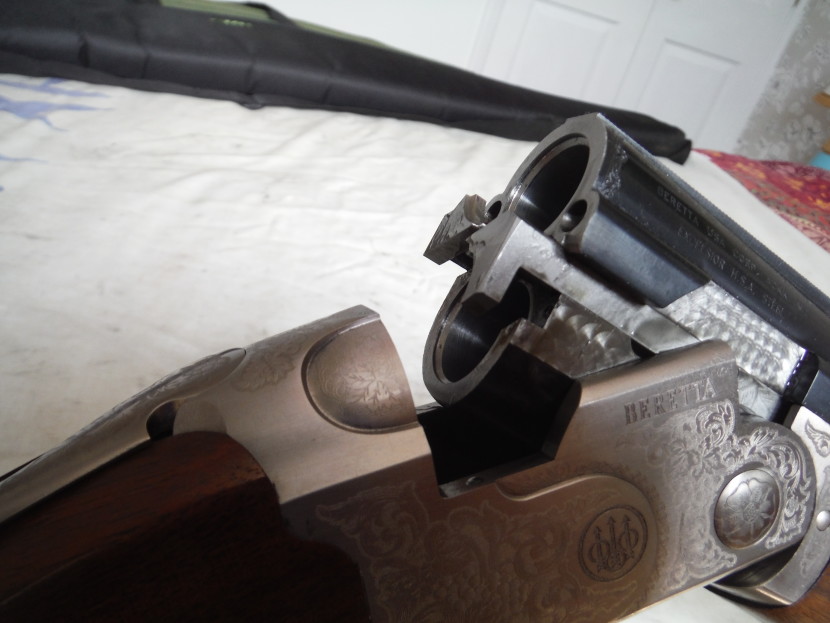 The gun is broken, cannot possibly fire and the chambers are visibly empty
The gun is broken, cannot possibly fire and the chambers are visibly empty Given all these protocols, to which in my experience sporting gunners adhere religiously, it seems extraordinary that the accident described above might have happened. Human error or rather extreme carelessness seems to have been the key factor and the conviction was one of reckless negligence. About the same time as this local case, we also heard of the fire arms incident on a Hollywood western film set involving actor Alec Baldwin, a hand gun and the death of a crew member. Clearly a different set of safety protocols are in use when creating the illusions for making a film and so a professional armourer would have been part of the team, but one might wonder why on earth live ammunition was even present on the set. It seems some crew members may have been playing at target shooting in their free time. The matter is I suppose sub judice but Baldwin himself has already told the media very earnestly that he would never, ever point a gun at somebody and pull the trigger. But immediately afterwards he stated with equal earnestness that he did pull back the external hammer with finger and thumb and then release it. He didn’t seem to be aware of the implications of the statement he had just made. Given that this was an old-fashioned revolver, if it had a live round in the chamber that action would have detonated it. For that reason, the old Colts and other famous 6 shot revolvers of the 19th century Wild West were normally carried with just 5 rounds loaded and the hammer down on an empty chamber. They don’t tell you that in the movies. My own paternal grandfather lost a leg in the First War, not through enemy action, but in his case due to the negligent discharge of a rifle being cleaned in a dug-out.
By contrast with the American situation, hand-guns capable of firing a live round are no longer in circulation among civilians in this country, being forbidden even for sporting or target use. It was different when I was a child, when virtually everybody’s father seemed to have brought back a souvenir from the war. Up and down the street, they used to be hidden away inside the cut-out pages of books put away on innocent-looking shelves. Hopefully these have all been handed in during the various amnesties by now and subsequently been disabled by the police – but not before a school friend of mine who got into mind-altering substances committed suicide with one of those Luger pistol souvenirs.
In early November 2021, a time of high floods on all our rivers, four people from our area died in a single incident on the River Cleddau. Apparently they were paddle boarding. I don’t know if any comparative studies have been done between safety while using paddle boards and, say, canoes or rowing boats. However, it does seem to me the idea of standing in a wet suit upright on a sort of surf board attached to your leg by a cord while giving the odd paddle stroke may seem sensible enough when the river is on summer low level. But is it wise in a raging flood? In my youth I was regarded as quite a good swimmer, but I can remember one incident which thoroughly frightened me. A school friend had persuaded his father to drop us off on the Thames with a twin seat kayak, one of the old wood and canvas ones used at the time, with a plan to pick us up with the car 20 miles downstream at the end of the day. We were 12 or 13, I suppose, and we had made the trip several times before. However, it was now autumn and Father Thames was well up. It was one of the weir pools which got us. Of course we didn’t have life jackets or helmets or any such safety equipment. While trying with rapid paddle strokes to drive across the lion’s mouth of a wide open sluice, the current caught us on the beam and slammed us hard sideways against a line of vertical pilings. I have never felt such inexorable power as that of the current in that place. The canoe was slowly turned over with its force, open top side facing towards the flow, and then began to sink and go downstream. But as luck would have it, I managed to reach the top of the pilings with one hand, pulled myself up and then managed to pull my pal up after me. The canoe went on downstream upside down. Somebody with a skiff in calmer water round the bend managed to catch the canoe together with the paddles and kindly towed it back to us. We were slightly in shock, shivering on the bank, but eventually we emptied the boat and re-embarked. I had lost a jacket which had been spread on the canopy behind my seat. It could all have been much worse. Needless to say, we didn’t tell my friend’s father later exactly what had happened, although I expect we came up with some story to explain our wet condition. In the case of the Cleddau incident, which involved experienced paddlers, a person was charged by police with manslaughter after the fourth death. The Cleddau rivers, by the way, are not navigable.
Not quite such a serious matter perhaps, but before leaving the subject of safety, I think I should mention again the stiles on Abercynrig, both upper and lower, which are in a very bad state, rotting, broken and loose in the ground. On behalf of clients and others, and before somebody has a nasty accident – we aren’t all young and spry – can I ask that the owners or their agents rectify the access arrangements across fences for this beat?
My working life is a busy one at this time of the year. Even after 14 years of it I can’t imagine a nicer activity than taking people fishing, but guiding and teaching does use up some time and energy. New clients sometimes ask: “how often do you do this?” almost as if it might be an occasional amusement. Five or six times a week is the answer, at least during the high season, when I don’t get much time to fish for myself. I think I once did 10 days on the trot. The secret of keeping going is to make time for occasional quiet moments. I rather like the early morning spells when the tackle is made up and all I need to do is sit, drink coffee from the flask and wait for the client to arrive. You see things when the countryside is quiet early in the day. There are almost always birds and the other morning on the Usk at Abercynrig I was watching the martins whirling around over their river bank burrows, trying to work out if they had found a hatch of fly. There were also two herons quite close to each other on the gravel flats upstream, but very different herons. One was the familiar British grey heron, a very big specimen this one, well over half the height of a man as he stalked the shallows. In a while Old Nog took flight and showed the size of his wings as he flapped off towards Brecon, a pterodactyl of a bird. He’s the fellow I’m happy to see on the river, but not around my garden pond. The other heron remained out there on the pool tail and this was a much smaller creature, the white cattle egret, which seems to have abandoned Egypt’s Nile and the marshes of southern Iraq flooded annually by the Tigris and Euphrates in order to adopt our colder streams. I see them now as often as the native species.
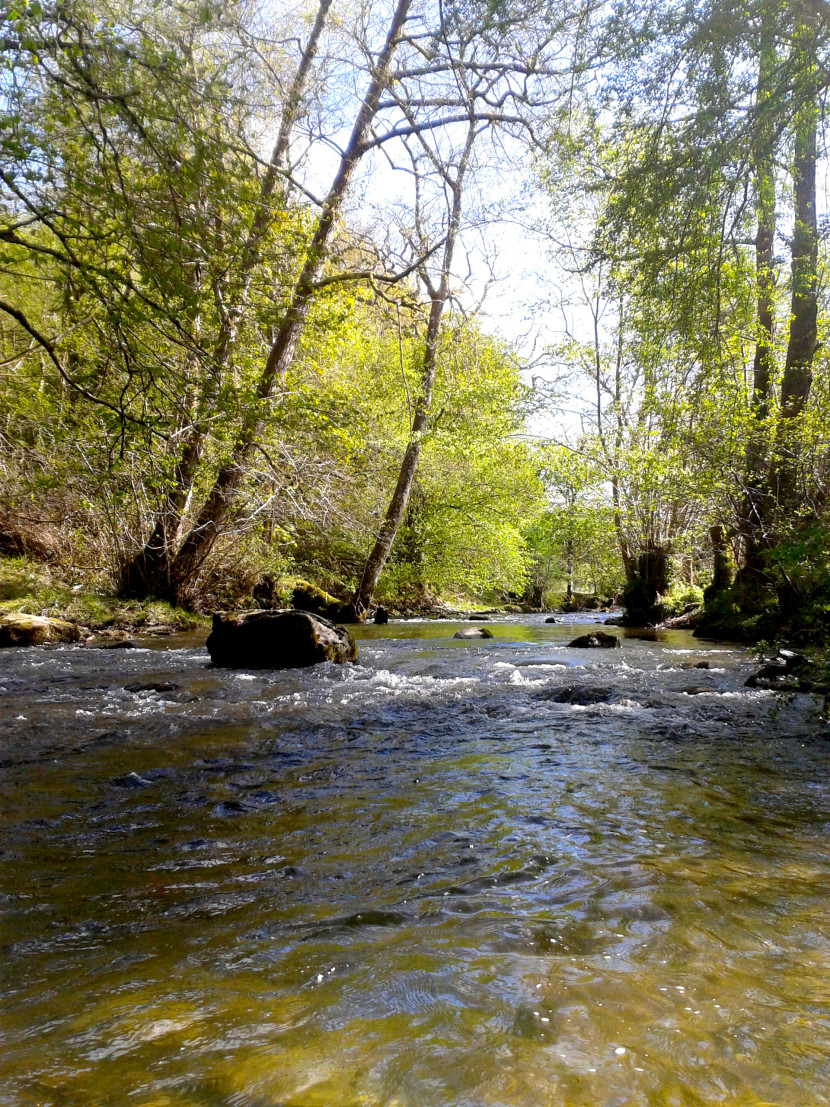 Spring on the Edw
Spring on the Edw Another day I was waiting in the field corner car park at Goodrich Court when a roe deer suddenly came bounding through the hedge into view. I was standing by my car with my cup of coffee, and as soon as she looked my way she knew at once that something was not quite safe about the situation. I remained absolutely stock-still; she kept looking up in my direction, but I took care not to move a muscle. So she took heart and began to jump around in circles in front of me. She wasn’t going anywhere and she was not feeding, although she was now in acres of long, lush grass which has been neither grazed nor mowed this year. It struck me then that she was just jumping and bounding through the green for the sheer delight of it. The next time I was waiting in the same place, a hare arrived and hopped past the open door of the car. Again I froze and the hare came within a few feet. I often come across a hare in these large Herefordshire fields and I’m always heartened when I do. There is something lucky about seeing one, or I like to think so. It’s also a place for skylarks, more often heard than seen, but as uplifting as their song. Otters are usually unexpected, but every so often one comes along to remind me of the wilder side of life on our rivers and to make me feel blessed. I don’t mind so very much about the fish they take, although others do.
The other day I was out with a young client with keen eyes and a set of polarized glasses. The Usk was as low and clear as I have ever seen it and he quickly picked out a series of adult eels lying out of cover in full daylight. Why would eels, who normally come out from under the stones at night, behave like that? All I can say is that the day was a close and thundery one and we saw flashes of lightning the night before. I have often noticed eels behaving strangely when there seems to be electricity in the air or thunder is rumbling in the distance. I suspect that later in the year such conditions may begin to provoke migration.
I have always thought of the jackdaw as the cockiest and wisest of the corvids. It must be something about his jaunty gait, the way he turns his head to this side and that, and his relative fearlessness around humans. You have the idea that he always knows what he is doing and knows a bit more than you. He also seems to be a religious sort of bird, as he is always hanging around churches. Is that perhaps something to do with the Ingoldsby Legends and the Jackdaw of Rheims who was eventually canonized? “You and I are the greatest here” the confident Jackdaw is supposed to have confided to the Cardinal. At any rate, ever since we came to live down by the lychgate of St Mary’s Church we have acquired the company of jackdaws, who march up and down on the green outside, indeed soberly dressed in clerical black and grey, but pecking up worms and eying us with a slightly superior look, not quite so religious now but more like cockney market traders looking for potential customers. I take them to be good neighbours, so far at least, and in any case we would never do anything so risky as to leave jewellery by an open window.
The rivers are still ultra-low at the time of writing, so I think we should all pray for rain. Otherwise, we should see some more mayfly in June, so tight lines!
Oliver Burch